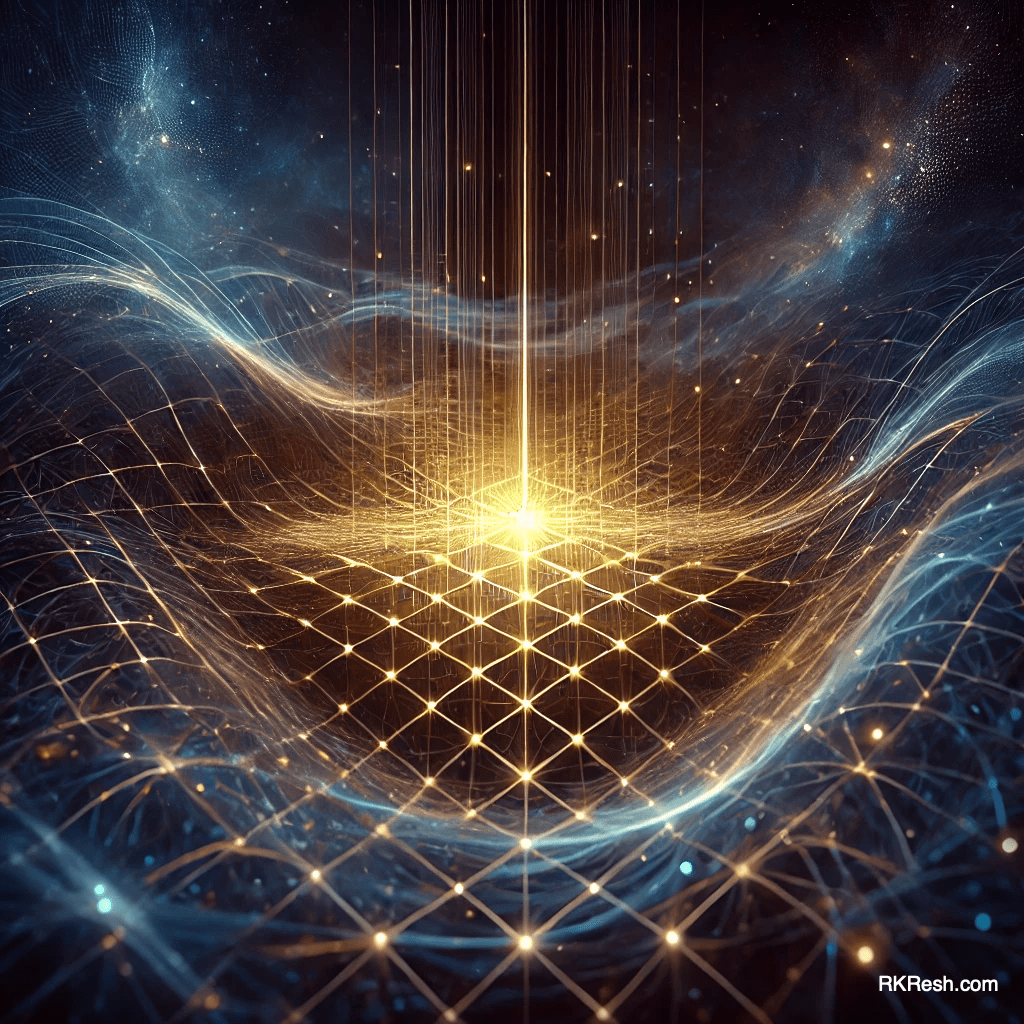Attention and a Quantum Field: Is There a Link?
001 Quantum fields are the unseen threads weaving the fabric of reality. More than mere settings for particles, they form a vast, interconnected energy web that shapes the universe. Delve into the mystery where science meets philosophy, and uncover how these forces influence existence itself.

Attention Series 001
I’ve long been fascinated by the idea of attention as an intangible force that shapes our perception of reality in ways we don’t fully comprehend. During my time in Egypt, I began to think of attention as a form of energy —something I could consciously direct. This sparked a deeper curiosity about the nature of this force, how it operates, and whether it could be theoretically scaled. These questions eventually led me to explore the realm of quantum mechanics. Thus, the larger inquiry was born to take form in this series of articles.

I’m intrigued by the concept of attention as a force that selects possibilities from the vast pool of potential, shaping a focal point that plays a role in assembling our reality. I see this "pool of potential" as analogous to the quantum field, where particles emerge. Just as particles arise from the vibrations of strings, forming matter from what appears to be "nothing," our thoughts might similarly emerge from the fluctuations of an information field, guided and shaped by focused attention.
To begin, let's get a handle on what quantum field is. The universe is a tapestry of invisible threads, weaving together the very fabric of reality. These threads, known as quantum fields, are the foundation of everything we see, touch, and even imagine. While the concept of quantum fields may sound like something out of a science fiction novel, they are the undercurrent of existence as we know it, connecting every particle, every wave, and every moment of existence.
If you’ve always wondered how the universe works at its most fundamental level—or if you’re simply curious how physics and metaphysics intertwine—this is your invitation to explore. Together, we’ll peel back the cosmic curtain and peer into the wondrous complexities of quantum fields.
Quantum Fields: The Invisible Fabric of Reality
Imagine walking on a vast, calm lake. The water stretches out to infinity, unbroken and quiet. This is a metaphor for a quantum field. A quantum field is a continuous, all-encompassing entity that fills the entire universe. It is not made of matter; rather, it is the medium in which matter exists.
At its core, a quantum field is an energy field, vibrating with potential—like the still water waiting for ripples to form. Importantly, there’s not just one quantum field. Each type of particle—such as electrons, quarks, and photons—has its corresponding field. These fields overlap, interact, and coalesce into the symphony of creation.
But what sets quantum fields apart from more familiar concepts, like waves in the ocean or sound vibrations, is their scale and purpose. A quantum field isn’t a physical object we can touch or see—it’s an abstract, mathematical entity. Yet it governs the behavior of particles, the very building blocks of matter.
Where classical physics focuses on tangible objects like planets and orbits, quantum physics asks us to think in terms of probabilities, potentials, and unseen forces. A quantum field, then, isn’t just “something out there.” It exists everywhere, influencing everything—unfolding reality moment by moment.
How Particles Emerge from Quantum Fields
To understand particles, think of ripples forming on the surface of a lake. A still lake becomes animated when a pebble drops into it, creating ripples that radiate outward. These ripples, in quantum physics, are akin to particles—disturbances within a quantum field.
I (and many others) also like to conceptualize it as knots forming in the loose strings that become excited. They are not excited out of joy at meeting one another, but because, for example, some force is applied to them.
This understanding flips the classical idea of particles on its head. Instead of imagining particles as tiny, independent dots of matter, quantum physics teaches us that particles are excitations of their corresponding fields.
For example, an electron isn’t a solid particle zipping through space. Instead, it’s a localized ripple, or a knot, in the “electron field.” A photon, the particle of light, is a ripple in the “electromagnetic field.” What appears to us as discrete points of matter are, at their essence, vibrations in an ocean of energy.
This realization opens up fascinating questions about the nature of existence. If all particles are ripples in fields—emerging and dissolving in a constant dance of probabilities—then what does it mean to exist?
Quantum Fields as the Connective Tapestry
Here’s where things get profound. Because quantum fields exist everywhere and underlie everything, they connect all of reality in ways we’re only beginning to comprehend. A single event in one part of a field can influence distant points—even across vast distances.
This phenomenon, known as quantum entanglement, marries particles in such a way that their behaviors remain linked regardless of the space between them. Physics calls entanglement “spooky action at a distance,” but it reveals something deeper about the universe—a subtle and intimate interconnectedness that defies classical understanding.
On a cosmic level, quantum fields remind us that separation is an illusion. Though our senses perceive boundaries, the fields weave us together in a seamless web of existence.
Could Attention interact with Quantum Field?
Now, consider a bold and imaginative question. Could attention itself function like a force that causes excitations in quantum field? Or is it interacting with the field of consciousness, instead? Perhaps, they are one and the same? Could the focus of our awareness create ripples that shape reality?
Here’s the thought experiment: Just as particles emerge from quantum fields as excitations, could the objects of our attention emerge as “excitations” in the field of consciousness? For example, when we focus our attention on a goal, does that act of focusing amplify its likelihood of becoming real?
Here’s the thought experiment: Just as particles emerge from quantum fields as excitations, could the objects of our attention emerge as “excitations” in the field of consciousness?
Ancient philosophies and modern metaphysics have long suggested that attention is not a passive act but a creative one. Much like quantum fields, consciousness connects us to everything we observe. It bends possibility into shape, making the abstract tangible—or perhaps, turning the intangible into the real.
Quantum physics doesn’t fully answer this question yet, but it opens the door for new perspectives on how unseen forces—be they quantum or consciousness fields—shape what we perceive as reality.
A Brief Look at the History and Theory
For those intrigued by the science, the history of quantum fields offers a fascinating glimpse into humanity’s intellectual evolution. Celebrated physicist Richard Feynman revolutionized the way we think about fields with his early diagrams, which beautifully illustrated particle interactions. His writings make daunting concepts accessible, even for beginners.
On the metaphysical side, Michel Talbot’s “The Holographic Universe” presents a compelling hypothesis of reality as a projection of interconnected energy fields. If the universe is indeed holographic, quantum fields might be the scaffolding of that projection—a master design where each piece reflects the whole.
Both perspectives—scientific and metaphysical—invite us to rethink reality as something far more intricate and interconnected than we once believed.
Charting the Next Wave of Curiosity
Our exploration of quantum fields is just one ripple in an infinite pond. These invisible, omnipresent entities invite us to keep asking questions—not for definite answers, but for the insight and wonder they inspire. Questions like these are not meant to uphold a singular "One-Truth" framework for understanding human nature, nor are they intended to fuel debates over the validity of evidence. Instead, I view this inquiry as an opportunity to foster unity by encouraging trust in our inner worlds—our personal experiences and that persistent sense that something greater exists beyond the realm of material proof. While we can only perceive the effects of this "something," not the essence of it, its presence invites us to explore and connect on a deeper, more intuitive level.
Whether you approach quantum fields as a scientist, a philosopher, or a dreamer, the discovery lies not in conclusions but in connections. Perhaps quantum fields are not merely the stage for reality but part of a grander play we have yet to fully script.
Curious about what’s next? Stay tuned. Our next article will venture deeper into how unseen forces might shape not only the physical world but also the subjective world of thought, perception, and reality itself.





Comments ()